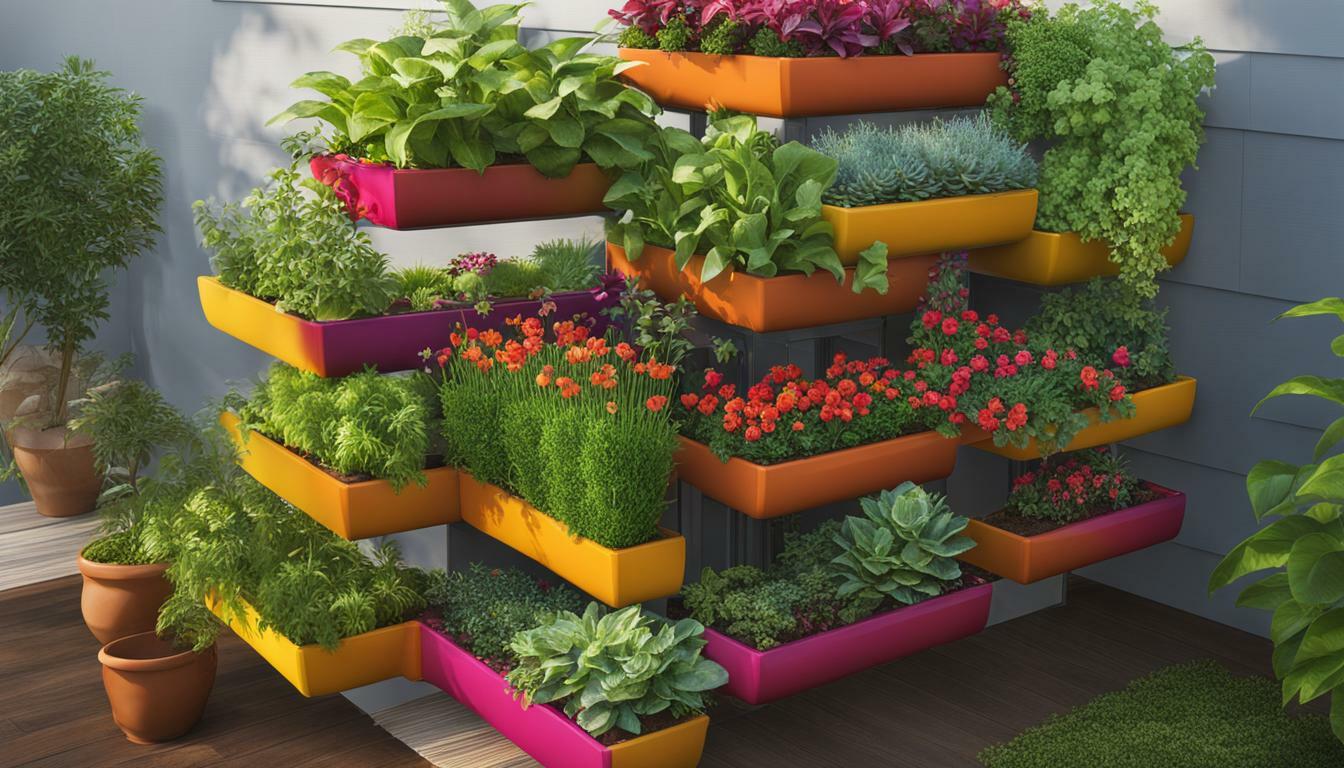Are you looking to optimize your gardening space and maximize your green thumb? Consider a vertical raised garden bed. These innovative gardening solutions are a game-changer for both experienced gardeners and beginners alike. Vertical raised garden beds offer a range of benefits, allowing you to make the most of limited space and create a stunning landscape right in your own backyard.
Key Takeaways:
- Vertical raised garden beds provide improved control over soil conditions, easier access, and prevention of soil erosion.
- They offer endless creative possibilities, such as utilizing recycled materials, exploring vertical designs, and incorporating themed gardens.
- Setting up a raised garden bed requires careful consideration of location, soil selection, and plant choice.
- Calculating the amount of soil needed for a raised garden bed can be done using a simple formula.
- Maximizing space in a raised bed garden can be achieved with the use of vertical gardening structures and techniques.
- Customizing your raised bed garden allows you to select suitable cultivars, practice efficient planting methods, and apply square foot gardening principles.
- Proper spacing in a raised bed garden is essential for optimal growth and disease prevention.
- Small-space gardening techniques, such as vertical gardening and efficient planting methods, can be applied to raised bed gardens.
- Home gardening brings joy and satisfaction, allowing you to enjoy the fruits of your labor.
- Continuous learning and growth in gardening is important to improve your raised bed garden over time.
- Vertical raised garden beds offer endless possibilities and the opportunity to embark on an exciting gardening adventure.
The Benefits of Raised Garden Beds
Raised garden beds offer numerous benefits for both experienced and novice gardeners alike. These elevated structures, essentially large planting boxes, provide improved control over soil conditions, easier access for planting and maintenance, prevention of soil erosion, and a natural deterrent to pests. With raised garden beds, you can optimize your gardening space and create a beautiful landscape right in your own backyard.
One of the major advantages of raised garden beds is the ability to have better control over the soil. By filling the beds with high-quality soil and compost, you can create the ideal growing environment for your plants. This is especially beneficial if you have poor soil quality in your yard. Additionally, raised garden beds allow for easier access, as they are elevated off the ground, reducing the strain on your back and knees. This makes planting, weeding, and harvesting a more enjoyable and efficient process.
Another key benefit of raised garden beds is the prevention of soil erosion. The raised structure helps to keep the soil in place, even during heavy rain or watering. This is particularly important if you live in an area prone to erosion. Raised garden beds also act as a natural barrier to pests, such as rabbits or groundhogs, since the height makes it more difficult for them to access your plants.
With raised garden beds, the possibilities for creativity are endless. You can utilize recycled materials to build your beds, such as old furniture or wooden crates, adding a unique touch to your garden. Furthermore, you can explore vertical gardening designs to maximize your growing space. By going vertical, you can grow more plants in a smaller area, making it ideal for those with limited space. Themed garden beds, edible landscapes, and the incorporation of architectural structures like trellises or pergolas are also creative ideas to consider.
| Advantages of Raised Garden Beds | Benefits |
|---|---|
| Improved soil control | Optimize soil conditions for plant growth |
| Easier access | Reduce strain on back and knees |
| Prevention of soil erosion | Keep soil in place during heavy rain |
| Pest deterrence | Create a barrier to pests |
| Creative possibilities | Utilize recycled materials, explore vertical designs, incorporate themed gardens, and more |
“Raised garden beds allow for improved soil control, easier access, prevention of soil erosion, and pest deterrence. The creative possibilities for raised garden beds are endless, from utilizing recycled materials to exploring vertical designs and incorporating themed gardens.”
The Benefits of Raised Garden Beds
In addition to the advantages mentioned above, raised garden beds offer numerous benefits for gardeners of all levels. They provide an opportunity to create a customized garden space that suits your unique needs and preferences. With raised garden beds, you can maximize your gardening space, grow a diverse range of plants, and enjoy the beauty and satisfaction of homegrown produce.
Whether you’re a seasoned gardener or just starting out, raised garden beds are a practical and aesthetically pleasing option. So, why not tap into the thriving world of horticulture and optimize your green thumb with a vertical raised garden bed?
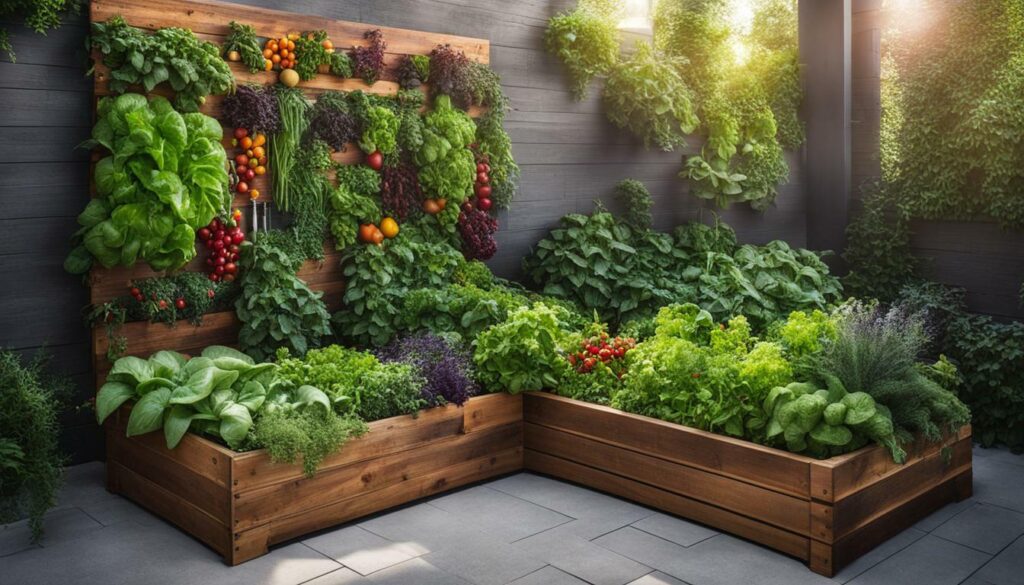
Creative Ideas for Vertical Raised Garden Beds
Get inspired with these creative ideas for your vertical raised garden bed. Vertical gardening is a fantastic way to optimize space and create a stunning, productive garden. Whether you have limited ground space or simply want to add visual interest to your garden, these ideas will help you take your gardening game to new heights.
1. Utilize Recycled Materials
If you’re eco-conscious and love a good DIY project, consider using recycled materials to build your vertical raised garden bed. Pallets, old furniture, or discarded wooden crates can be repurposed and give your garden a unique, rustic charm.
2. Explore the Vertical
Traditional raised garden beds are horizontal, but why not think outside the box? Vertical raised beds are a great option for those with limited space. By growing your plants vertically, you can maximize your growing area while adding an eye-catching element to your garden.
3. Theme-Based Garden Beds
Add a touch of creativity and organization to your garden by creating theme-based raised beds. Consider planting a monochrome white garden or a sensory garden bed filled with plants that engage all five senses. This allows you to express your personality while creating a visually stunning and organized space.
4. Wagon Wheel Design
For a unique and visually appealing garden bed, try a wagon wheel design. In this setup, your raised garden bed is divided into sections that radiate out from a central point, resembling the spokes on a wagon wheel. Each section can hold a different plant, adding variety and making it easier to manage your garden.
5. Edible Landscaping
Combine functionality and aesthetics by creating an edible raised garden bed. Plant a variety of herbs, vegetables, and fruits to not only enjoy a beautiful garden but also harvest fresh and delicious produce right at your doorstep.
6. Incorporate a Greenhouse
Take your raised garden bed to the next level by adding a mini-greenhouse. A greenhouse allows you to extend the growing season, protect delicate plants from harsh weather conditions, and provide a controlled environment for optimal growth.
7. Add a Trellis or Pergola
Elevate your garden’s visual appeal and maximize vertical space by adding a trellis or pergola to your raised garden bed. These structures provide support for climbing plants like roses, grapes, and cucumbers, adding an architectural element to your garden.
With these creative ideas, you can transform your vertical raised garden bed into a beautiful and productive space. The possibilities are endless, so let your imagination run wild and create a garden that reflects your unique style and gardening preferences.
| Idea | Description |
|---|---|
| Utilize Recycled Materials | Repurpose pallets, old furniture, or wooden crates for a rustic look. |
| Explore the Vertical | Grow plants vertically to maximize space and create visual interest. |
| Theme-Based Garden Beds | Create organized and visually striking beds based on a specific theme. |
| Wagon Wheel Design | Divide your garden bed into sections radiating from a central point for a unique design. |
| Edible Landscaping | Plant a variety of herbs, vegetables, and fruits for both beauty and harvest. |
| Incorporate a Greenhouse | Add a mini-greenhouse to extend the growing season and protect delicate plants. |
| Add a Trellis or Pergola | Elevate your garden’s visual appeal and create vertical growing space. |
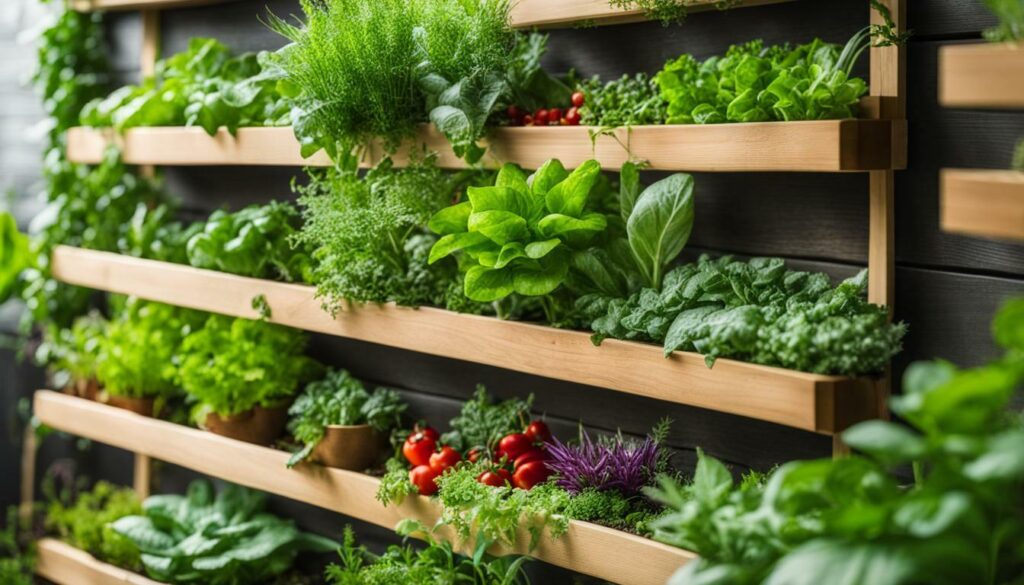
Tips for Setting Up a Raised Garden Bed
Setting up a raised garden bed requires careful consideration and proper planning. Whether you’re a seasoned gardener or just starting out, these tips will help you create a successful raised bed garden.
Choose the Right Location
Selecting an ideal location for your raised garden bed is crucial to the success of your plants. Look for a spot that receives at least 6-8 hours of direct sunlight per day. This will ensure that your plants have enough light to grow and thrive.
Pick Suitable Soil
The soil you use in your raised garden bed plays a significant role in the health and productivity of your plants. It should be fertile, well-draining, and rich in nutrients. Consider creating your own soil mix using equal parts compost, peat moss or coconut coir, and vermiculite or perlite. This will provide a good balance of organic matter, moisture retention, and aeration.
Select the Right Plants
When choosing plants for your raised garden bed, consider the specific conditions in your garden and the climate of your area. Select plants that are suitable for your growing zone and have similar light and water requirements. This will help ensure that your plants thrive and produce a bountiful harvest.
Consider Crop Rotation
Practicing crop rotation in your raised garden bed can help prevent the buildup of diseases and pests. It involves changing the location of certain types of vegetables each year to disrupt the life cycle of pests and reduce the risk of soil-borne diseases. Make a plan for rotating your crops each year to maximize the health and productivity of your raised bed garden.
Watering Wisely
While raised beds offer better drainage than traditional in-ground gardens, they can also dry out more quickly. Monitor the moisture level of your soil regularly and water your garden accordingly. Avoid overwatering, as it can lead to root rot and other plant diseases.
Regular Maintenance
Maintaining your raised garden bed is essential for the health and productivity of your plants. Regularly check for weeds, pests, and diseases, and take appropriate action to prevent or address any issues. Prune and harvest your plants as needed, and keep the garden clean and tidy to minimize the risk of pests and diseases.
By following these tips, you can set up a successful raised garden bed and enjoy a bountiful harvest of fresh, homegrown produce.
| Tips for Setting Up a Raised Garden Bed |
|---|
| Choose the Right Location |
| Pick Suitable Soil |
| Select the Right Plants |
| Consider Crop Rotation |
| Watering Wisely |
| Regular Maintenance |
How to Calculate Soil Quantity for Your Raised Garden Bed
Before starting your raised garden bed project, it’s important to calculate the correct amount of soil needed. This will ensure that you have enough soil to fill your bed and provide optimal growing conditions for your plants. Here’s a simple soil calculator to help you determine the amount of soil required:
| Step | Calculation |
|---|---|
| Step 1 | Calculate the total width of your garden in feet (W) |
| Step 2 | Calculate the total length of your garden in feet (L) |
| Step 3 | Calculate the total height of your garden in feet (H) |
| Step 4 | Multiply all three together: W x L x H |
The answer to this equation is the total cubic feet of soil you need for your raised bed. For example, if your garden has dimensions of 4 feet wide, 8 feet long, and 1.5 feet high, the calculation would be: 4 x 8 x 1.5 = 48 cubic feet of soil required.
It’s important to note that the soil calculator assumes a rectangular or square-shaped garden bed. If your raised bed has a different shape, you may need to make adjustments to the calculations. Additionally, keep in mind that the soil will settle over time, so it’s a good idea to slightly overestimate the amount of soil needed to account for this settling.
Remember, having the right amount of soil is crucial for the health and success of your raised garden bed. With this soil calculator, you can confidently plan and prepare your garden, ensuring that your plants have the space and nutrients they need to thrive.
Example Calculation:
Let’s say you have a raised garden bed that measures 4 feet wide, 8 feet long, and 1.5 feet high, and you want to calculate the amount of soil required. Using the formula W x L x H, the calculation would be:
4 feet (width) x 8 feet (length) x 1.5 feet (height) = 48 cubic feet of soil.
So, to fill your raised garden bed, you would need approximately 48 cubic feet of soil.
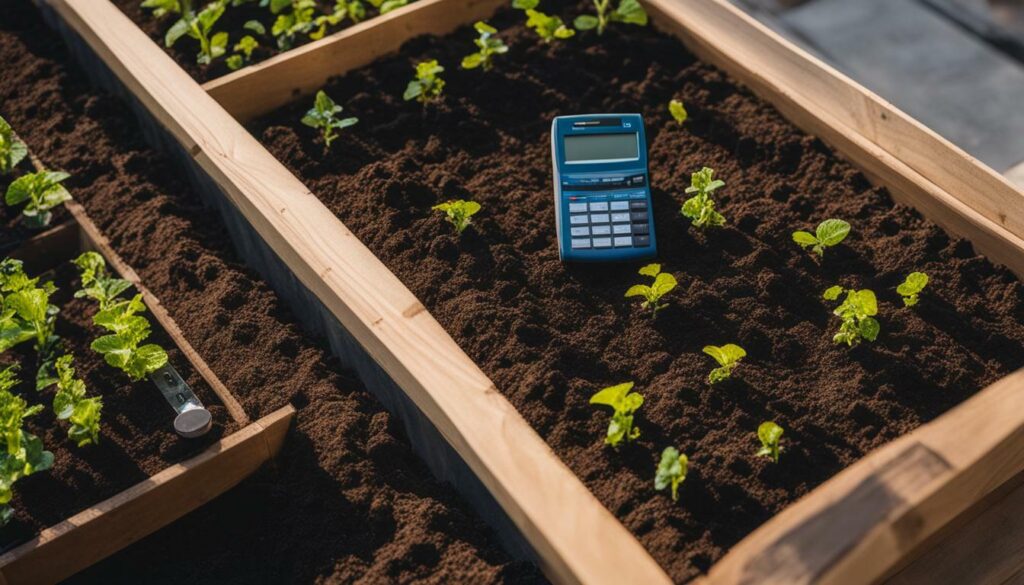
Use this simple soil calculator to accurately determine the amount of soil needed for your raised garden bed and enjoy a flourishing garden filled with healthy, vibrant plants.
Maximizing Space in a Raised Bed Garden
Maximize your gardening space with these techniques specifically designed for raised bed gardens. Raised bed gardens offer a versatile and compact solution for those with limited space or challenging terrain. With a little creativity and strategic planning, you can make the most of your raised bed garden and achieve bountiful yields.
One technique to maximize space in a raised bed garden is by using vertical gardening structures. Vertical gardening allows you to grow plants upwards, utilizing the vertical space above your raised bed. You can construct trellises, arbors, or use hanging baskets to grow vining plants like tomatoes, cucumbers, or pole beans. This not only saves ground space but also adds visual interest to your garden.
Another space-saving technique is to create a vertical herb garden. Herbs are compact plants that can thrive in small spaces. You can use hanging planters, vertical wall gardens, or tiered shelving to grow a variety of herbs. By utilizing the vertical space, you can cultivate a wide range of herbs while keeping your garden compact and organized.
In addition to vertical gardening, you can also customize your raised bed garden to maximize space. Consider planting suitable cultivars for limited space, such as dwarf or compact varieties. These plants are specifically bred to be smaller in size, making them ideal for raised bed gardens. You can also practice mounding to increase the depth of your bed without digging further into the soil. Mounding involves gradually adding soil or compost to the base of plants as they grow, creating more surface area for the plant to produce a crop.
Maximizing Space in a Raised Bed Garden: Tips and Techniques
- Utilize vertical gardening structures like trellises and arbors.
- Create a vertical herb garden using hanging planters or tiered shelving.
- Plant suitable cultivars for limited space, such as dwarf or compact varieties.
- Practice mounding to increase the depth of your bed without digging.
By implementing these strategies, you can make the most of your raised bed garden and optimize your gardening space. Whether you have a small balcony or a sprawling backyard, raised bed gardens offer endless possibilities for maximizing space and creating a thriving garden.
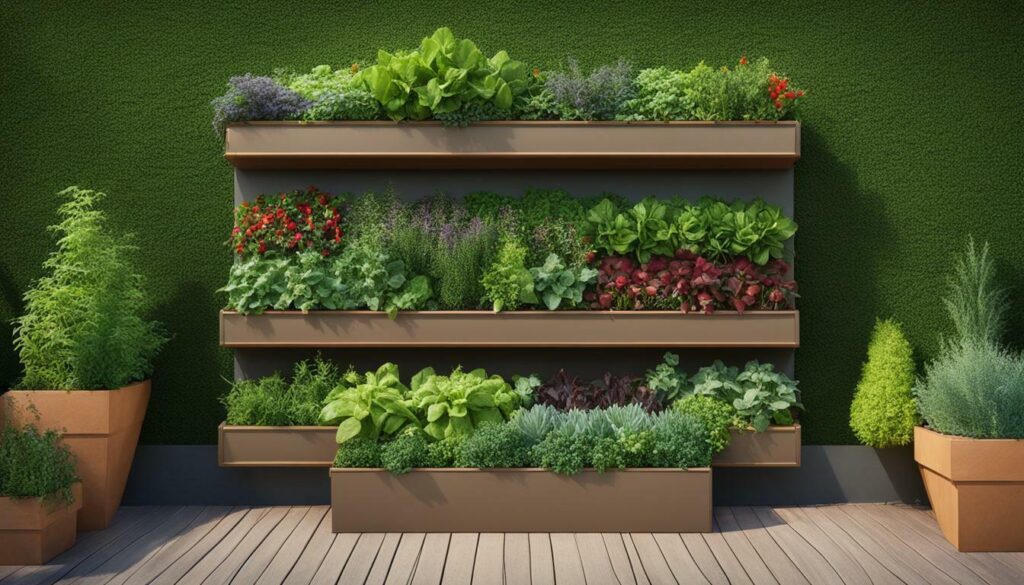
Customizing Your Raised Bed Garden
Customize your raised bed garden to suit your specific needs and preferences. Whether you’re an experienced gardener looking for new challenges or a beginner eager to start your gardening journey, there are endless possibilities to make your raised bed garden unique and tailored to your liking.
Here are some ideas to inspire you:
- Utilize Recycled Materials: If you’re environmentally conscious and enjoy DIY projects, repurpose materials such as pallets, old furniture, or discarded wooden crates to create your raised garden bed. This not only reduces waste but also adds a rustic charm to your garden.
- Explore the Vertical: Instead of sticking to traditional horizontal raised beds, consider going vertical. Vertical raised beds maximize space and provide the same benefits as horizontal beds while taking up less ground area.
- Theme-Based Garden Beds: Choose a theme for your raised bed garden, whether it’s based on colors, scents, or even sensory experiences. Organizing your garden bed based on a theme adds visual appeal and keeps your garden organized.
- Wagon Wheel Design: For a unique aesthetic, create a wagon wheel design in your raised garden bed. Divide the bed into sections that radiate from a central point, resembling the spokes of a wagon wheel. Each section can have a different plant, making it visually interesting and easy to manage.
- Edible Landscaping: Combine functionality and aesthetics by creating an edible raised garden bed. Plant a variety of herbs, vegetables, and fruits, allowing you to enjoy the beauty of the garden while reaping the rewards of your labor.
- Incorporate a Greenhouse: Take your raised garden bed to the next level by adding a mini-greenhouse. This extends the growing season and protects delicate plants from harsh weather conditions, making it ideal for gardening in colder climates.
- Add a Trellis or Pergola: Enhance the height and structure of your raised garden bed by incorporating a trellis or pergola. This provides support for climbing plants such as roses, grapes, and cucumbers, adding an architectural element to your garden.
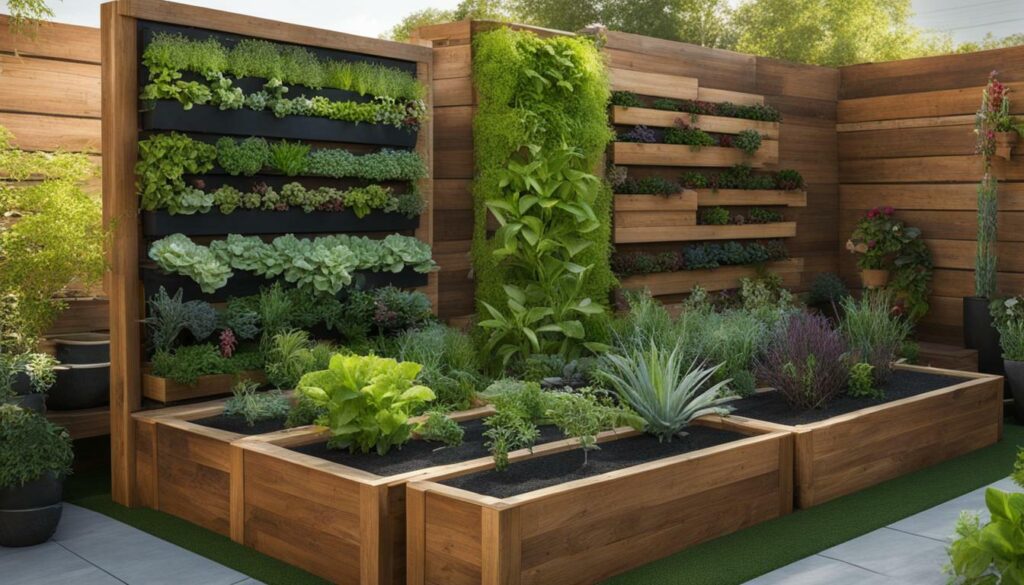
These customizable options allow you to transform your raised bed garden into a personalized oasis. Select cultivars suitable for limited space, consider fast-harvesting plants, practice mounding for increased depth, and apply square foot gardening principles to maximize productivity.
Customization Tips for Raised Bed Gardens
When customizing your raised bed garden, keep the following tips in mind to ensure success:
- Choose the Right Location: Select a location that receives at least 6-8 hours of direct sunlight daily, as most plants thrive in these conditions.
- Pick Suitable Soil: Use a fertile, well-draining soil mix for your raised bed. Consider creating your own blend using equal parts compost, peat moss or coconut coir, and vermiculite or perlite.
- Select the Right Plants: Choose plants that are suitable for your climate and the specific conditions in your garden. Check the plant hardiness zone for your area to ensure optimal growth.
- Consider Crop Rotation: Practice crop rotation in your raised bed garden to prevent the buildup of diseases and pests. Change the location of certain vegetables each year.
- Watering Wisely: Monitor the moisture level of your soil regularly and water your raised bed garden accordingly. While raised beds drain well, they can also dry out more quickly.
- Regular Maintenance: Engage in regular weeding, pruning, and harvesting to keep your plants healthy and productive. Regularly inspect your plants for signs of pests or diseases.
- Patience is Key: Gardening requires patience. Allow your plants time to grow and produce, and don’t expect instant results.
- Learn and Grow: Embrace gardening as a journey of continuous learning. View mistakes as opportunities to improve, and use each season to enhance your raised bed garden.
The joy of home gardening lies in the ability to customize your raised bed garden to suit your preferences and needs. With creativity, careful planning, and proper maintenance, your garden will thrive and bring you endless satisfaction.
Conclusion
Customizing your raised bed garden allows you to create a unique and personalized gardening space. From utilizing recycled materials to exploring the vertical, incorporating themed designs, and adding architectural structures, the possibilities are endless. By selecting suitable plants, optimizing space, and practicing proper maintenance, you can create a garden that reflects your passion for nature and rewards you with bountiful harvests. Start customizing your raised bed garden today and embark on an exciting gardening adventure!
The Importance of Proper Spacing in a Raised Bed Garden
Proper spacing is crucial for the success of your raised bed garden. When plants are overcrowded, they compete for resources such as water, nutrients, and sunlight, leading to smaller yields, weaker plants, and increased risk of diseases and pests. It’s important to give each plant enough space to grow and thrive.
Here are some tips to help you determine the appropriate spacing for your raised bed garden:
- Refer to seed packets: Seed packets usually provide information on how far apart each plant should be spaced. While these recommendations are often based on commercial agriculture practices, you can use them as a starting point and adjust according to your unique space constraints.
- Consider plant size: Choose cultivars that are suitable for containers or raised beds, as they are usually more compact and require less space. Dwarf or determinate varieties can be a better option than indeterminate types, as they have a more confined growth habit.
- Maximize vertical space: Take advantage of the vertical space in your raised bed garden by using trellises or stakes for climbing plants. This allows you to grow more plants in a smaller area, freeing up ground space for other crops.
- Utilize intensive planting methods: Square foot gardening is an intensive planting technique that maximizes space by dividing the growing area into small squares. Each square is then planted with a specific number of plants, depending on their size and spacing requirements.
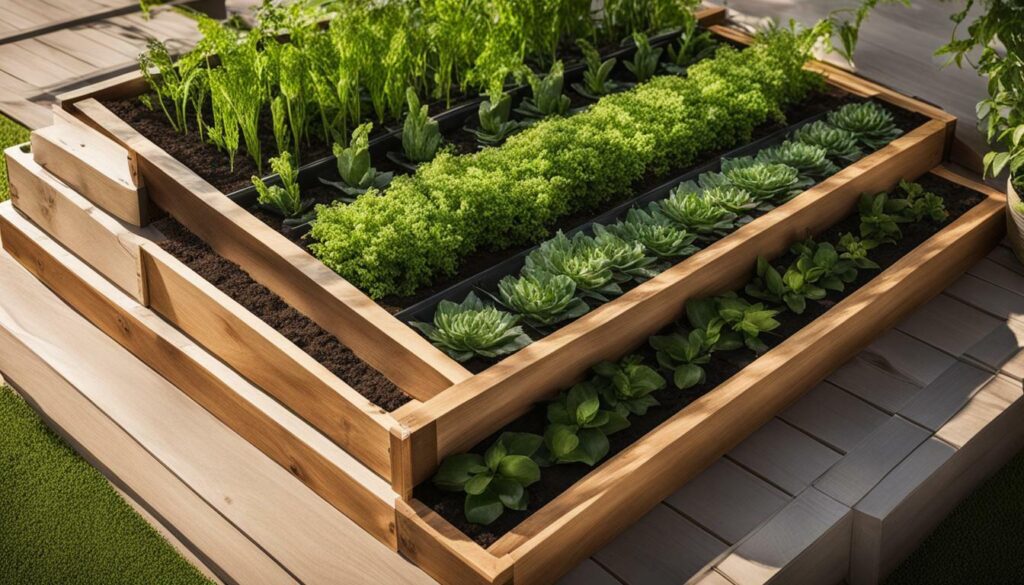
Remember that proper spacing is not just about the width and length of your raised bed, but also about the depth and the amount of vertical space you can create. By selecting suitable cultivars, utilizing vertical gardening techniques, and using efficient planting methods, you can make the most of your raised bed garden and achieve higher yields.
Spacing Recommendations for Common Vegetables
| Vegetable | Spacing |
|---|---|
| Tomatoes | 18-24 inches apart |
| Lettuce | 4-6 inches apart |
| Cucumbers | 12-24 inches apart |
| Peppers | 12-18 inches apart |
| Carrots | 2-3 inches apart |
“Proper spacing allows plants to receive adequate sunlight, air circulation, and access to nutrients, which are essential for healthy growth and development.” – Gardening Expert
By giving your plants the space they need, you’ll create an optimal growing environment and set the stage for a successful and productive raised bed garden.
Small-Space Gardening Techniques for Raised Bed Gardens
Discover small-space gardening techniques that can be applied to your raised bed garden. Whether you have limited gardening space or simply want to maximize the productivity of your raised beds, these techniques will help you make the most of your garden.
One technique that proves especially useful in small-space gardening is the use of vertical gardening structures. By utilizing trellises, arbors, or other vertical structures, you can train plants to grow upward, saving valuable ground space. Vertical gardening not only maximizes the number of plants you can grow but also adds visual interest to your garden.
In addition to vertical gardening, another technique for small-space gardening in raised beds is creating an elevated garden bed. Elevating your garden can provide benefits such as improved drainage, better soil aeration, and easier access for gardening tasks. This is particularly helpful for gardeners with limited mobility or those aiming for a more ergonomic gardening experience.
When planning your raised bed garden, it is also important to consider efficient planting methods. Square foot gardening, for example, is an intensive planting method that divides the growing space into smaller sections to maximize the number of plants grown. By carefully calculating the spacing requirements of each plant, you can optimize the use of your raised bed and increase productivity.
| Small-Space Gardening Techniques for Raised Bed Gardens |
|---|
| Utilize vertical gardening structures |
| Create an elevated garden bed |
| Implement efficient planting methods, such as square foot gardening |
“Vertical gardening not only maximizes the number of plants you can grow but also adds visual interest to your garden.”
Example of Square Foot Gardening
One well-known technique in small-space gardening is square foot gardening. This method divides the raised bed into square-foot sections, providing a structured layout for plant placement. By following the recommended spacing for each plant, you can fit a larger variety of crops in the raised bed. An example layout for a 4×4-foot raised bed is as follows:
| Plant | Number of Plants Per Square Foot |
|---|---|
| Lettuce | 4 |
| Carrots | 16 |
| Radishes | 16 |
| Tomatoes | 1 |
| Peppers | 1 |
By following this spacing guide, you can maximize the productivity of your raised bed while still allowing each plant enough space to grow and thrive. Remember to adjust the spacing according to the specific needs of each plant and the conditions of your garden.
By implementing these small-space gardening techniques in your raised bed garden, you can create a productive and visually appealing garden, even with limited space. Whether you choose to utilize vertical structures, elevate your garden bed, or practice efficient planting methods like square foot gardening, these techniques will help you make the most of your raised bed garden.
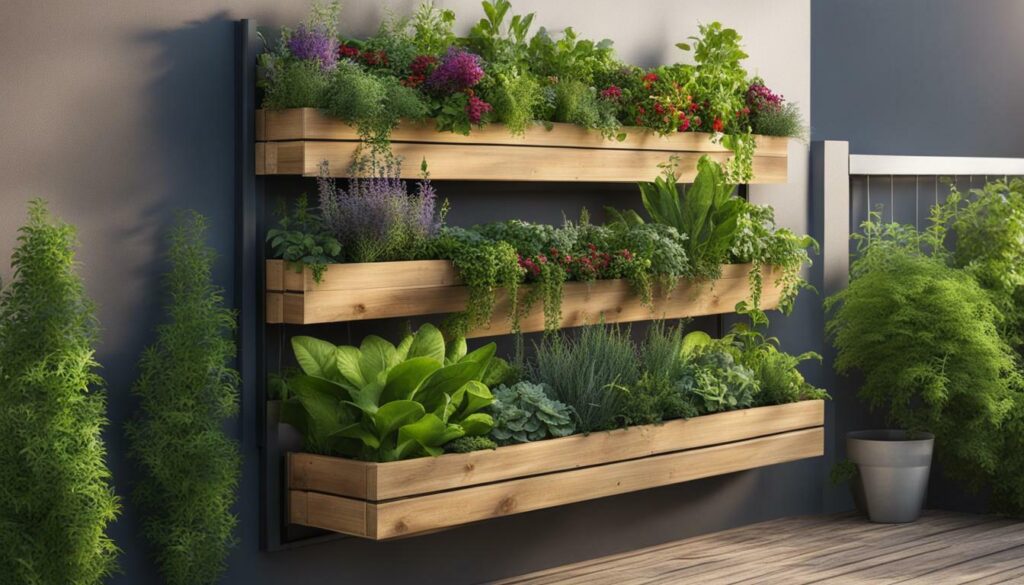 [Image source](https://seo writing.ai/32_6.png)
[Image source](https://seo writing.ai/32_6.png)The Joys of Home Gardening
Explore the joys and benefits of home gardening with a vertical raised garden bed. Whether you have a spacious backyard or a small balcony, a vertical raised garden bed allows you to create your own oasis of greenery and cultivate your favorite plants in a limited space. Not only does it provide a sense of fulfillment and satisfaction, but it also offers numerous advantages for both experienced gardeners and beginners.
One of the greatest joys of home gardening is being able to grow your own produce. There is nothing quite like the taste of freshly harvested fruits and vegetables that you have nurtured from seed to plate. With a vertical raised garden bed, you can grow a variety of crops right at your doorstep, ensuring that you always have a supply of fresh, organic, and flavorful ingredients for your meals.
Additionally, home gardening allows you to connect with nature and enjoy the therapeutic benefits of spending time outdoors. Tending to your plants, feeling the soil in your hands, and watching your garden flourish brings a sense of peace and tranquility. It provides an escape from the hustle and bustle of everyday life and allows you to reconnect with the natural world.
Furthermore, home gardening offers the opportunity to personalize your living space and create a beautiful and inviting environment. A vertical raised garden bed can be a stunning feature in your outdoor or indoor space, adding vibrancy, color, and texture to your surroundings. You can experiment with different plant combinations, create visually appealing designs, and even incorporate vertical structures such as trellises or garden planters to maximize your available space and enhance the aesthetic appeal of your garden.
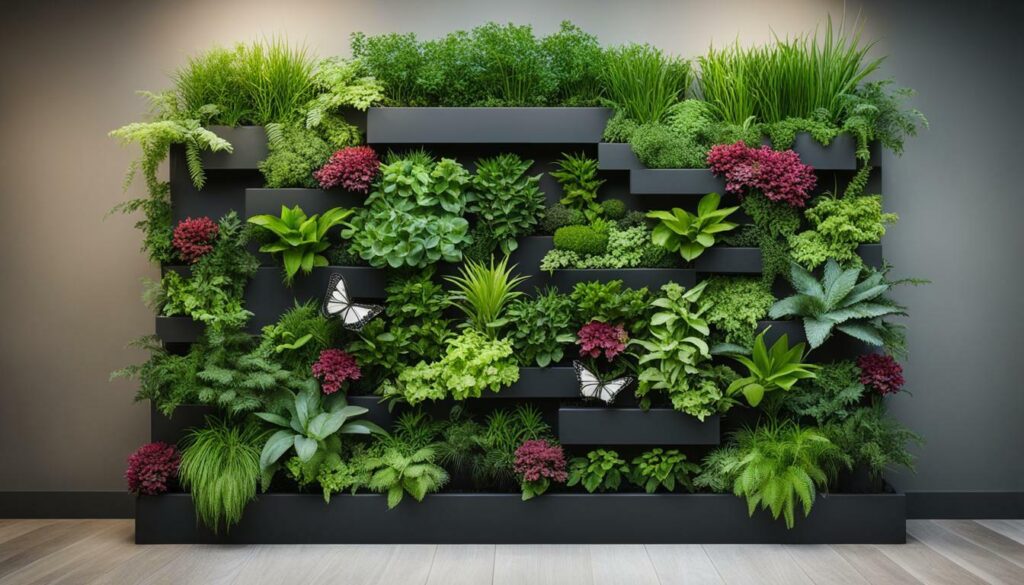
Overall, home gardening with a vertical raised garden bed is a rewarding and fulfilling activity that allows you to reap the benefits of fresh produce, connect with nature, and create a beautiful and personalized space. Whether you are a seasoned gardener or just starting out, the joys of home gardening are within reach with the versatility and possibilities offered by a vertical raised garden bed.
Continuous Learning and Growth in Gardening
Gardening is a journey of continuous learning and growth. As you embark on your raised bed gardening adventure, you will discover new techniques, explore different plant varieties, and encounter both successes and challenges. Each season presents an opportunity to improve your gardening skills and enhance the productivity of your raised garden beds.
One key aspect of continuous learning in gardening is staying open to new ideas and creative approaches. As you explore the world of vertical gardening, you’ll find that there are endless possibilities to maximize your space and optimize your yields. Consider incorporating a vertical herb garden into your raised bed setup, using trellises or pergolas to add height and structure, or even constructing a greenhouse to extend your growing season.
Learning from others is also an important part of gardening. Seek advice from experienced gardeners, join online gardening communities, or attend local workshops and seminars. These resources can provide valuable insights, tips, and tricks that will help you overcome challenges and achieve greater success in your raised bed gardens.
The Joy of Learning from Mistakes
“Gardening requires a lot of patience and experimentation. Don’t be afraid to make mistakes, as they are valuable learning opportunities.”
One of the joys of gardening is the opportunity to learn from your mistakes. Whether it’s overwatering, underestimating the space requirements of certain plants, or encountering unexpected pests, every setback is a chance to gain knowledge and improve your gardening practices. Embrace these learning experiences and use them to refine your techniques and strategies.
Remember that gardening is a continuous process, and there is always room for growth. Each season brings new lessons, new challenges, and new opportunities to improve. With each harvest and each planting, you’ll gain more experience and confidence in your gardening skills. So, embrace the journey, be open to learning, and watch as your raised garden beds flourish and thrive.
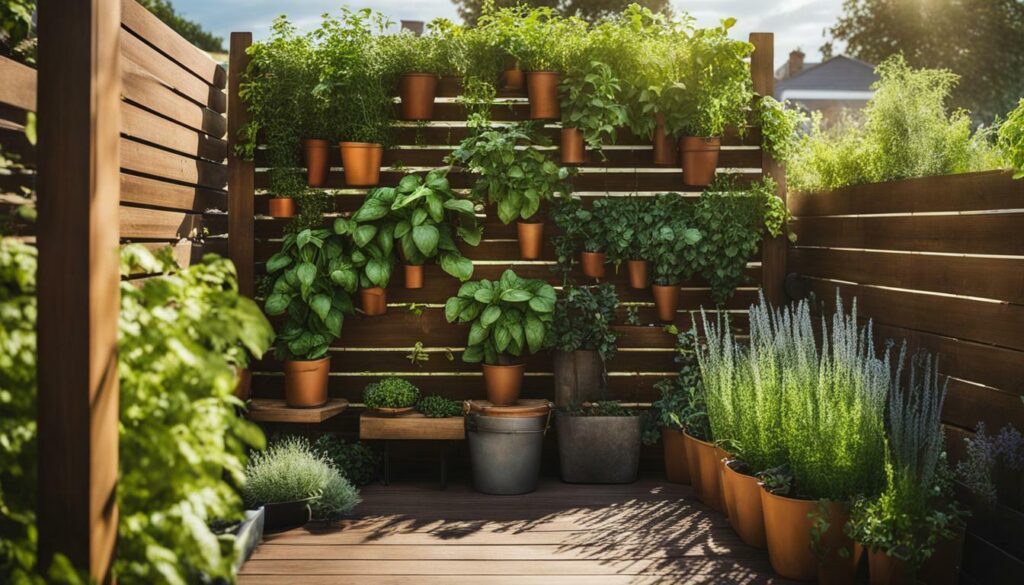
| Key Points |
|---|
| Continuous learning and growth are essential in gardening. |
| Explore new ideas, techniques, and plant varieties to enhance your raised bed gardens. |
| Seek advice from experienced gardeners and participate in gardening communities to learn from others. |
| Embrace mistakes as valuable learning opportunities and use them to improve your gardening practices. |
| Remember that gardening is a journey, and each season presents new opportunities for growth and improvement. |
Conclusion
Vertical raised garden beds offer endless possibilities for gardening enthusiasts, providing both functionality and aesthetic appeal. These innovative gardening structures optimize space, improve soil control, and make gardening more accessible. With raised garden beds, you can prevent soil erosion, deter pests, and create a visually stunning landscape in your own backyard.
When it comes to designing your raised garden bed, there are numerous creative ideas to explore. You can utilize recycled materials for an eco-friendly approach, or experiment with vertical designs to maximize space. Consider incorporating themed gardens to express your personality and create a visually striking display. The wagon wheel design adds a unique touch, while edible landscaping combines functionality and beauty. Adding a greenhouse extends the growing season, and trellises or pergolas bring height and structure.
To set up your raised garden bed, follow these tips for success. Choose the right location with ample sunlight, select suitable soil that is fertile and well-draining, and consider the specific plants that thrive in your climate. Crop rotation can prevent the buildup of diseases and pests, while watering wisely and regular maintenance ensure healthy growth. Remember, gardening is a continuous learning process, so embrace mistakes and use each season as an opportunity to improve.
Calculating the amount of soil you need for your raised garden bed is essential. Use a simple soil calculator to determine the total cubic feet of soil required based on the width, length, and height of your garden bed. By maximizing space in your raised bed garden and utilizing vertical gardening structures, you can achieve higher yields and optimize your small gardening space.
In conclusion, raised garden beds provide a versatile canvas for your gardening adventures. They offer the opportunity to customize your garden, choose suitable cultivars, and practice efficient planting methods. The joys of home gardening are abundant, from the satisfaction of growing your own produce to the pleasure of enjoying fresh, homegrown fruits and vegetables. Embrace the continuous learning and growth that gardening offers, and let your vertical raised garden bed become the centerpiece of your horticultural journey.
How Can I Incorporate a DIY Living Wall into my Vertical Raised Garden Bed?
Looking to combine a DIY living wall with a vertical raised garden bed? Check out our step-by-step DIY living wall tutorial for easy instructions on how to incorporate a lush and vibrant living wall into your garden. With just a few materials and some greenery, you can create a stunning green space.
FAQ
Q: How do I calculate the amount of soil needed for my raised garden bed?
A: To calculate the amount of soil needed for your raised garden bed, you can use the following formula: Multiply the width of the garden bed by the length and then by the height. The result will give you the total cubic feet of soil needed.
Q: What are some tips for setting up a raised garden bed?
A: Here are some tips for setting up a raised garden bed: – Choose an ideal location that receives adequate sunlight. – Use fertile and well-draining soil for optimal plant growth. – Select plants that are suitable for your climate and garden conditions. – Practice crop rotation to prevent the buildup of diseases and pests. – Monitor the moisture level of the soil and water accordingly. – Regularly maintain your garden by weeding, pruning, and harvesting. – Remember that gardening requires patience and continuous learning.
Q: How can I maximize space in a raised bed garden?
A: There are several techniques you can use to maximize space in a raised bed garden: – Utilize vertical gardening structures to grow plants upwards. – Create a vertical herb garden to make the most of limited space. – Practice mounding, which involves adding soil or compost around growing plants to increase depth and surface area. – Apply square foot gardening principles to optimize planting space. – Select cultivars that are suitable for containers or raised beds and consider fast-harvest plants for increased productivity.
Q: Why is proper spacing important in a raised bed garden?
A: Proper spacing is important in a raised bed garden to ensure optimal growth, prevent overcrowding, and minimize the risk of diseases and pests. Planting vegetables too closely together can lead to smaller fruits, weak plants, and increased susceptibility to fungal diseases. Adequate spacing allows for proper air circulation, nutrient absorption, and sunlight exposure.
Q: What are some small-space gardening techniques for raised bed gardens?
A: Some small-space gardening techniques that are applicable to raised bed gardens include: – Selecting suitable cultivars that are suitable for containers or raised beds. – Utilizing vertical gardening structures to make the most of limited space. – Applying efficient planting methods such as square foot gardening. – Using vertical growing techniques to maximize yield without requiring extra ground space. – Considering fast-harvest plants and early maturing cultivars to optimize productivity per bed.
Q: What are the joys of home gardening?
A: Home gardening brings numerous joys and benefits, including: – The satisfaction of growing your own produce and enjoying fresh, homegrown fruits and vegetables. – The opportunity to connect with nature and spend time outdoors. – The ability to customize your garden according to your preferences and needs. – The joy of nurturing plants and witnessing their growth and development. – The sense of accomplishment in successfully growing your own food.
Q: Why is continuous learning and growth important in gardening?
A: Continuous learning and growth are important in gardening because they enable you to improve your skills, knowledge, and techniques. Each gardening season presents opportunities to learn from mistakes, experiment with new methods, and expand your understanding of plants and their needs. Embracing continuous learning allows you to evolve as a gardener and make your raised garden beds even more successful.

